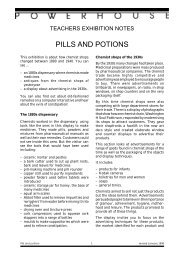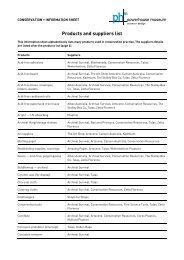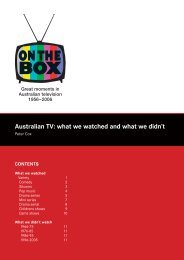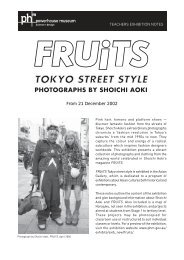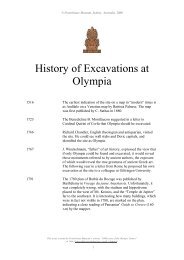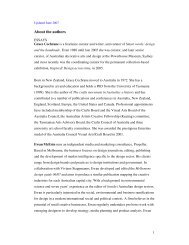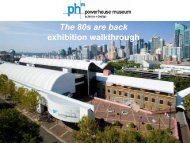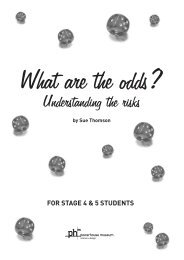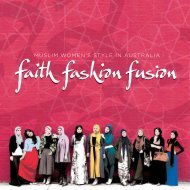+the magazine of the powerhouse museum summer 04/05
+the magazine of the powerhouse museum summer 04/05
+the magazine of the powerhouse museum summer 04/05
Create successful ePaper yourself
Turn your PDF publications into a flip-book with our unique Google optimized e-Paper software.
+ 20 powerline <strong>summer</strong> <strong>04</strong>/<strong>05</strong><br />
WHAT WERE THE HIGHS AND LOWS OF PRESENTING A MAJOR<br />
INTERNATIONAL EXHIBITION IN A NEW MUSEUM SPACE IN A CITY<br />
GRIPPED BY OLYMPIC FEVER? THE INSIDE STORY OF OUR PLACE.<br />
STEVE MILLER, EDUCATION OFFICER FOR ABORIGINAL PROJECTS<br />
inside our place<br />
The start <strong>of</strong> <strong>the</strong> press conference was running a little<br />
late. Half <strong>the</strong> troupe <strong>of</strong> Indigenous dancers had<br />
arrived and looked a little lost and <strong>the</strong> o<strong>the</strong>r half<br />
actually were lost. On only <strong>the</strong>ir second day in<br />
Greece, just as <strong>the</strong> rest <strong>of</strong> us had experienced at<br />
least once during <strong>the</strong> installation period, <strong>the</strong>y had<br />
become victims <strong>of</strong> taxi drivers who had not yet<br />
grasped that this new Benaki Cultural Centre was not<br />
at <strong>the</strong> old Benaki Museum site.<br />
Already unable to help with <strong>the</strong> showcase cleaning in<br />
<strong>the</strong> gallery because I was trying to sort out <strong>the</strong><br />
dancers’ transport difficulties, I now had to put aside<br />
<strong>the</strong>se curatorial responsibilities to prepare myself for<br />
a couple <strong>of</strong> hours <strong>of</strong> representing Indigenous<br />
Australia to a hopefully bilingual media.<br />
With no time to change into a suit and tie, my<br />
preparation, or at least ga<strong>the</strong>ring my thoughts, was<br />
achieved by standing outside in <strong>the</strong> 40-plus degree<br />
heat beside six lanes <strong>of</strong> traffic, hoping to flag down<br />
<strong>the</strong> missing dancers in a taxi with a driver who both<br />
spoke English and knew where <strong>the</strong> venue was.<br />
Strangely I found this state <strong>of</strong> affairs ra<strong>the</strong>r calming –<br />
in pre-Olympic and European-football-finals A<strong>the</strong>ns,<br />
chaos was a reasonably normal state. It was ever<br />
present in <strong>the</strong> air, literally, in <strong>the</strong> noise and <strong>the</strong> dust.<br />
Facing <strong>the</strong> assembled media in a panel with<br />
Powerhouse Museum Director Dr Kevin Fewster and<br />
Museum Victoria Chief Executive Officer Dr Patrick<br />
Greene, I couldn’t help but notice <strong>the</strong> incessant<br />
sideways glances in my direction from <strong>the</strong> 40 or so<br />
assembled journalists: ‘Hmm, so this is <strong>the</strong> Aborigine’<br />
<strong>the</strong>ir looks seemed to imply.<br />
‘I know all <strong>of</strong> you will have many questions about<br />
Indigenous Australia,’ I said by way <strong>of</strong> introduction to<br />
my session. ‘But right now I am sure <strong>the</strong> main<br />
question on all <strong>of</strong> your minds is: why does this<br />
Aboriginal man have freckles?’<br />
So began my attempts to explain <strong>the</strong> complexities <strong>of</strong><br />
contemporary Indigenous Australian life to a foreign<br />
culture as we had assembled it in Our place:<br />
Indigenous Australia now.<br />
A team <strong>of</strong> PHM Indigenous curators – James Wilson-<br />
Miller, Fabri Blacklock, Keith Munro, and myself – and<br />
our colleagues at Museum Victoria developed <strong>the</strong><br />
content for this exhibition for <strong>the</strong> A<strong>the</strong>ns Cultural<br />
Olympiad. We realised that <strong>the</strong> challenges <strong>of</strong><br />
interpretation were our primary consideration with this<br />
opportunity – <strong>the</strong> first time an Indigenous Australian<br />
exhibition had been presented in Greece.<br />
In Indigenous Australian cultures <strong>the</strong> stories<br />
associated with objects are <strong>of</strong> equal importance to<br />
<strong>the</strong> objects <strong>the</strong>mselves and should be treated with<br />
equal respect. So from <strong>the</strong> time <strong>of</strong> our first content<br />
workshops in December 2001 we decided that, given<br />
<strong>the</strong> difficulties <strong>of</strong> translations, <strong>the</strong> visual<br />
communication <strong>of</strong> <strong>the</strong> individual objects would have<br />
primacy in telling <strong>the</strong>ir stories. They would <strong>the</strong>n be<br />
woven toge<strong>the</strong>r to tell broader stories <strong>of</strong> relationship<br />
to spirit, country, kinship, and physical and political<br />
conflict. These links created a multi-layered<br />
understanding <strong>of</strong> where our cultural renewal and<br />
revival currently stands and <strong>of</strong>fered a cohesive and<br />
engaging narrative that was nei<strong>the</strong>r didactic nor<br />
overwhelming in <strong>the</strong> information it presented.<br />
The exhibition design by Tharawal woman Alison<br />
Page, who had previously worked on <strong>the</strong> Museum’s<br />
first permanent gallery <strong>of</strong> Indigenous cultures,<br />
Bayagul: contemporary Indigenous communication,<br />
drew <strong>the</strong>se elements toge<strong>the</strong>r. Her conceptual design<br />
envisaged a contemporary travelling Aboriginal camp<br />
with a central double-sided hanging wall <strong>of</strong> red and<br />
orange Perspex symbolising a campfire. It was<br />
surrounded by showcases based on traditional<br />
Aboriginal gunyas or windbreak shelters, each with its<br />
own hanging system, open display areas and variable<br />
display cases. These modular units were<br />
prefabricated in Australia, and <strong>the</strong>n shipped to<br />
A<strong>the</strong>ns by our sponsor Schenker.<br />
With this concept, <strong>the</strong> intention was to invite <strong>the</strong><br />
audience into our camp for <strong>the</strong> day to see, hear and<br />
experience stories <strong>of</strong> everyday life in Indigenous<br />
Australia. We realised <strong>the</strong> idea <strong>of</strong> stories around a<br />
campfire was an aspect <strong>of</strong> shared humanity, as old<br />
as civilisation itself, which was core to our<br />
communication – a subtle and diplomatic reminder <strong>of</strong><br />
our claim to being <strong>the</strong> world’s oldest living continuous<br />
culture.<br />
Comparative similarities between our cultures<br />
provided o<strong>the</strong>r elements <strong>of</strong> <strong>the</strong> contextual framework,<br />
from weaving and textiles, baskets, shields and<br />
spears to <strong>the</strong> shared histories <strong>of</strong> invasion and<br />
political discontent. There were also artists whose<br />
backgrounds drew on Aboriginal and Greek heritage<br />
and even commonalties in creation stories such as<br />
<strong>the</strong> Seven Sisters found across Australia and known<br />
to <strong>the</strong> Greeks as <strong>the</strong> star cluster Pleiades.<br />
FROM LEFT: SPIRIT, THE EXHIBITION’S FIRST THEMATIC SPACE, IS AN INTRODUCTION TO INDIGENOUS CULTURE AND PRESENTS ARTISTIC INTERPRETATIONS IN TRADITIONAL AND CONTEMPORARY<br />
MEDIA BASED ON SPIRITUAL BELIEFS. ARTWORKS REPRESENTING THE IMPACT OF COLONISATION INCLUDE TERROR NULLIUS PARTS 1 AND 2 BY BIRIPI ARTIST GORDON SYRON OF NSW. MUSIC AND<br />
DANCE HIGHLIGHTS INCLUDE TRIBUTES TO YOTHU YINDI AND BANGARRA DANCE THEATRE. A DISPLAY OF CONTEMPORARY WORKS IN NEW MEDIA INCLUDES WORKS BY DARREN SIWES, BROOK<br />
ANDREW AND CLINTON NAIN. AN EXAMPLE OF THE GUNYA SHOWCASE STRUCTURES. DISMANTLING THE EXHIBITION ARE NAYA ALEXANDRIS (BENAKI), ALISON BRENNAN (PHM REGISTRAR), VASSILIS<br />
PASCHALIS (BENAKI), AND PENNY NOLTON (MUSEUM VICTORIA CONSERVATOR). LOADING THE SEA FREIGHT IN ATHENS. LOADING THE AIR FREIGHT IN DUBAI. PHOTOS BY MALCOLM MCKERNAN.<br />
<strong>the</strong> exhibition



